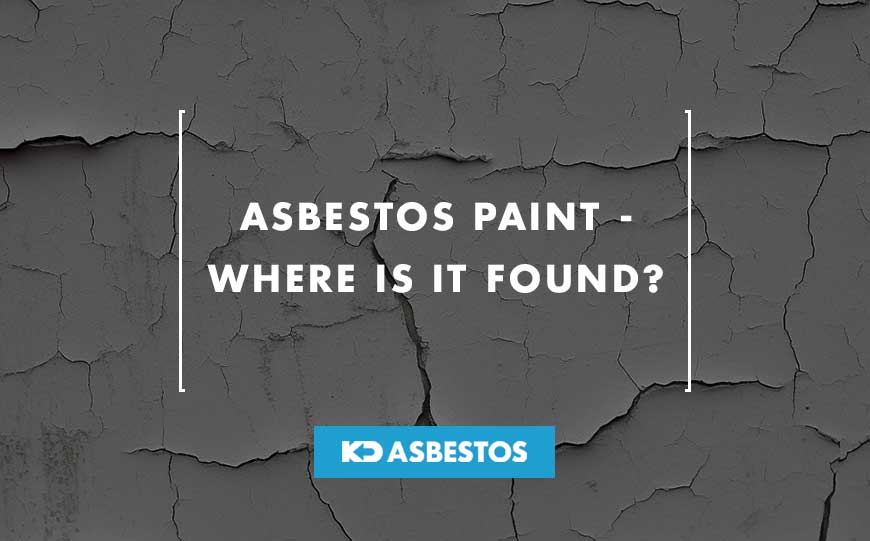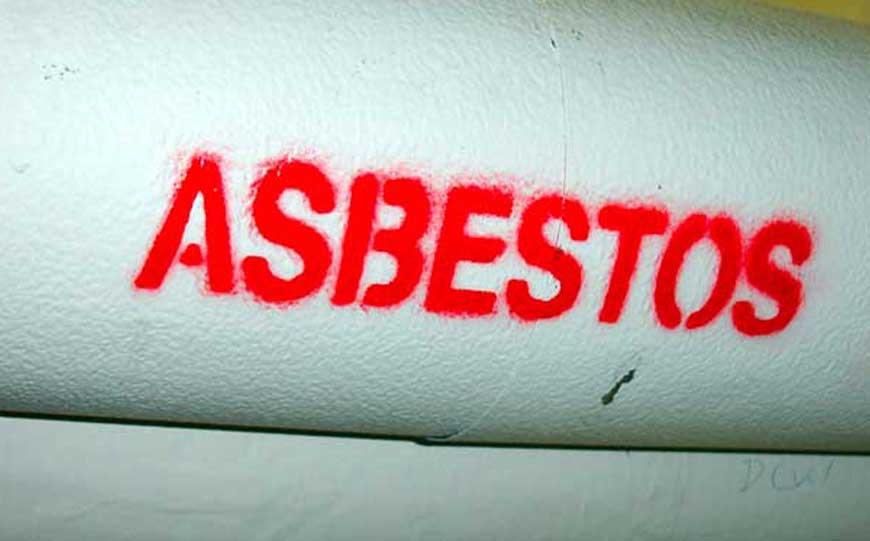
Asbestos paint can be a hidden danger inside your house or your place of work.
Once considered a miracle substance due to its fire-resistant and insulating properties, asbestos has been revealed as a hazardous material.
Understanding where asbestos paint is found and the risks associated with it is crucial for safeguarding your home and your health.
Table of Contents
What is Asbestos Paint?
Asbestos paint, once a widely utilised marvel in the construction industry, was a product that blended the versatility of paint with the fire-resistant and insulating properties of asbestos fibres.
Asbestos itself is a naturally occurring silicate mineral that was prized for its remarkable heat resistance, durability, and affordability.
Due to these qualities, it found its way into a multitude of construction materials, and paints were no exception.
The Uses of Asbestos Paint

The incorporation of asbestos fibres into paint served several purposes.
One of the primary advantages was its exceptional fire-resistant nature.
Asbestos fibres were highly effective at preventing fires from spreading, making asbestos paint a preferred choice, especially in environments where fire safety was a significant concern, such as industrial complexes, ships, and public buildings.
The heat resistance of asbestos also made it ideal for use in paints for surfaces that were exposed to high temperatures, such as pipes, boilers, and ovens.
Furthermore, asbestos paint provided excellent insulation properties.
Its ability to resist heat transfer made it valuable for insulating surfaces, ensuring that the underlying structures remained protected from extreme temperatures.
Apart from its fire-resistant and insulating attributes, asbestos paint was also known for its durability.
Surfaces coated with asbestos paint exhibited enhanced resistance to wear and tear, making them less susceptible to damage from physical abrasion and weathering.
This durability made asbestos paint a popular choice for applications where long-lasting protection was essential, such as on the exteriors of buildings and industrial equipment.
The Change in the Law
However, the once-praised qualities of asbestos paint eventually led to its downfall.
Asbestos exposure was linked to severe health issues.
As awareness about the health risks of asbestos exposure grew, the use of asbestos-containing materials, including asbestos paint, drastically declined.
Today, the use of asbestos in paint and other construction materials is strictly regulated or entirely banned in many countries.
Despite its historical significance, the dangers associated with asbestos have led to a shift towards safer alternatives in the construction and paint industries, emphasising the importance of prioritising both safety and innovation in modern building practices.
Where is Asbestos Paint Found?
Asbestos paint can be found in older buildings, especially those constructed before the 1980s when asbestos use in construction materials was prevalent.
Asbestos was banned in the UK in 1999.
This hazardous substance found its way into various parts of buildings due to its fire-resistant and insulating properties, making it a popular choice during that era.
Some of the most common places asbestos paint could be found was:
Walls and Ceilings

One of the common places where asbestos paint was applied is on walls and ceilings.
It was often used as a textured coating or as a primer layer before the final paint.
Its fire-resistant nature made it appealing for these surfaces, especially in commercial buildings and schools where fire safety standards were stringent.
Pipes
Asbestos-containing paint was frequently used to coat pipes and insulation materials.
Pipes in older buildings, particularly those used for plumbing or heating, were often coated with asbestos paint for its heat-resistant properties.
Structural Steel
Structural steel within buildings, especially in industrial settings, was often coated with asbestos paint.
This was done to protect the steel from fire damage, ensuring the structural integrity of the building.
Asbestos paint’s ability to withstand high temperatures made it an ideal choice for this purpose.
Ships and Industrial Facilities
Beyond buildings, asbestos paint was extensively used in ships and industrial facilities.
Ships, in particular, utilised asbestos-containing paints on various surfaces, including the hull, to provide fire protection in the event of engine or fuel-related fires.
Industrial facilities, where fire hazards were a constant concern, also applied asbestos paint for its fire-resistant qualities.
Commercial Buildings, Schools, and Hospitals
Older commercial buildings, schools, and hospitals are common places where asbestos paint can still be found.
Given the stringent fire safety regulations in these settings, asbestos-containing paints were frequently applied to meet the necessary standards.
Hospitals, where patient safety is paramount, often used asbestos paint in critical areas to enhance fire protection measures.
How Can You Identify Asbestos Paint?
Identifying asbestos paint requires a careful eye and, in most cases, the expertise of professionals due to its deceptive resemblance to regular paint.
Unlike other asbestos-containing materials, asbestos paint doesn’t have a distinct appearance, making visual identification challenging.
Here are some key aspects to consider when trying to identify asbestos paint:
Texture and Thickness
Asbestos-containing paint often has a unique texture.
It might appear thicker and chalkier than regular paint due to the asbestos fibers mixed within.
The embedded fibres can give the surface a rough texture that sets it apart from conventional smooth paints.
However, relying solely on texture is not a foolproof method, as other factors can create similar textures in non-asbestos paints.
Age of the Building
The age of the building is a significant clue.
Asbestos-containing paints were widely used before the 1980s.
If you’re dealing with a structure constructed before this period, especially if it hasn’t undergone significant renovations, the likelihood of finding asbestos-containing materials, including paint, increases substantially.
This historical context can guide your suspicions and prompt a closer inspection.
Professional Inspection

Given the challenges of visual identification, it’s crucial to involve professionals trained in asbestos inspection.
Asbestos inspectors have the experience and tools necessary to collect samples safely and send them to accredited laboratories for analysis.
These laboratories employ advanced techniques to detect asbestos fibres accurately, providing a definitive answer about the presence of asbestos in the paint.
Laboratory Analysis
Laboratory analysis is the gold standard for identifying asbestos-containing materials.
Asbestos-containing paint samples are carefully collected by professionals following strict safety protocols.
These samples are then sent to specialised laboratories equipped to handle asbestos analysis.
Microscopic examination techniques, such as polarised light microscopy (PLM) or transmission electron microscopy (TEM), are used to identify asbestos fibres in the samples.
The results of these analyses can confirm whether the suspected paint contains asbestos.
DIY Test Kits (with caution)
There are asbestos testing kits available for consumers, allowing individuals to collect samples and send them to labs for analysis.
While these kits can provide insights, caution is essential. Improper sampling techniques can lead to false negatives, especially if the asbestos fibres are not well-distributed in the material.
It’s often safer and more accurate to rely on professional inspectors for asbestos testing.
What are the Dangers of Asbestos Paint?
The exposure to asbestos paint is dangerous due to the inhalation of asbestos fibres.
When the paint deteriorates or is disturbed, tiny asbestos particles can become airborne.
Inhalation of these fibres can lead to serious health issues.
Inhalation Hazards
The primary danger associated with asbestos paint lies in the inhalation of asbestos fibres.
Asbestos, when disturbed, can release microscopic particles into the air.
These particles are so small that they remain suspended for extended periods, making them easy to inhale.
When asbestos-containing paint deteriorates due to ageing, physical damage, or renovation activities, these fibres can become airborne, posing a severe health risk.
Health Impacts
Inhaling asbestos fibres can lead to various life-threatening diseases, with some of the most concerning being lung cancer, asbestosis, and mesothelioma.
Lung Cancer
Long-term exposure to asbestos significantly increases the risk of developing lung cancer.
Asbestos-related lung cancer is aggressive and often has a poor prognosis.
Asbestosis
This is a chronic lung condition caused by the scarring of lung tissue due to prolonged exposure to asbestos fibres.
It can cause shortness of breath, coughing, and severe respiratory issues.
Mesothelioma
This is a rare and aggressive form of cancer that affects the lining of the lungs, abdomen, or heart.
Mesothelioma is exclusively caused by asbestos exposure, and its diagnosis is often grim due to its late-stage detection.
Low-Level Exposure Risks
Even minimal exposure to asbestos particles can lead to significant health problems.
Unlike some toxins where the risk is proportional to the level of exposure, asbestos has proven harmful even in low quantities.
Short-term exposure, such as during a home renovation project, can have long-term consequences.
This characteristic makes asbestos-containing materials, including paint, particularly hazardous, as individuals might not realise the extent of their exposure until health issues arise years later.
Environmental Concerns
Beyond the direct health risks, asbestos contamination also poses environmental concerns.
Asbestos fibres, once released into the air or water systems, can contaminate the surrounding environment.
Long-term environmental exposure can affect wildlife, soil quality, and, eventually, human populations.
Proper disposal methods for asbestos-containing materials are essential to prevent environmental contamination and protect ecosystems.
What to Do if You Find Asbestos Paint
Discovering asbestos paint in your home should prompt immediate action.
It’s crucial not to disturb the material further, as this could release more asbestos fibres into the air.
Instead, consult asbestos removal experts who are trained to handle these hazardous substances.
They can assess the situation, conduct proper testing using an asbestos surveyor, and safely remove the paint if necessary, ensuring your home is asbestos-free.
Conclusion
While asbestos paint may seem like a relic of the past, its presence in older buildings underscores the importance of vigilance in home maintenance and renovation projects.
Identifying and addressing asbestos-containing materials promptly is essential for the safety and well-being of your household.
By staying informed and seeking professional assistance when needed, you can ensure that your home remains a haven, free from the hidden dangers of asbestos paint.
For more information on the testing and removal of asbestos then get in touch with KD Asbestos.